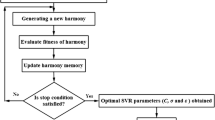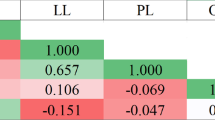Abstract
Determining the bearing capacity of ring foundations on rock masses holds utmost importance within the framework of foundation design methodology. To examine the failure mechanism of ring foundations situated on Hock-Brown rock masses, the crucial bearing capacity factor \({(N}_{\sigma })\) is analyzed. This analysis considered three dimensionless input parameters: the geological strength index (GSI), the yield parameter (mi), and the ratio of the internal and external radii (ri/ro). This study focuses on the development of a precise hybrid extreme learning machine (ELM) and least-square support vector machine (LSSVM) based on two swarm-based intelligence optimization algorithms, utilizing Harris hawks optimization (HHO) and particle swarm optimization (PSO). The primary objective of this study is to provide accurate predictions of the bearing capacity factor (\({N}_{\sigma }\)) for a ring foundation. Furthermore, the accuracy of the developed hybrid ELM-PSO, ELM-HHO, LSSVM-PSO, and LSSVM-HHO models was assessed through a comparison between the actual and predicted values of \({N}_{\sigma }\) using various performance metrics, uncertainty analysis, and rank analysis. The LSSVM-HHO and ELM-HHO outperformed the LSSVM-PSO and ELM-PSO models in predicting the \({N}_{\sigma }\) value. The proposed models can be used as soft computing tools to predict the \({N}_{\sigma }\) values in practical applications.











Similar content being viewed by others
Data availability
The datasets used and/or analyzed during the current study available from the corresponding author on reasonable request.
References
Azam A, Bardhan A, Kaloop MR, Samui P, Alanazi F, Alzara M, Yosri AM (2022) Modeling resilient modulus of subgrade soils using LSSVM optimized with swarm intelligence algorithms. Sci Rep 12(1):14454. https://doi.org/10.1038/s41598-022-17429-z
Bardhan A, Kardani N, Alzo’ubi AK, Roy B, Samui P, Gandomi AH, (2022) Novel integration of extreme learning machine and improved Harris hawks optimization with particle swarm optimization-based mutation for predicting soil consolidation parameter. J Rock Mech Geotech Eng 14(5):1588–1608. https://doi.org/10.1016/j.jrmge.2021.12.018
Benmebarek S, Remadna MS, Benmebarek N, Belounar L (2012) Numerical evaluation of the bearing capacity factor nγ′ of ring footings. Comput Geotech 44:132–138
Benmebarek S, Saifi I, Benmebarek N (2017) Undrained vertical bearing capacity factors for ring shallow footings. Geotech Geol Eng 35:355–364
Chakraborty M, Kumar J (2015) Bearing capacity of circular footings over rock mass by using axisymmetric quasi lower bound finite element limit analysis. Comput Geotech 70:138–149. https://doi.org/10.1016/j.compgeo.2015.07.015
Chihi O, Saada Z (2022) Bearing capacity of strip footing on rock under inclined and eccentric load using the generalized hoek-Brown criterion. Eur J Environ Civ Eng 26:2258–2272. https://doi.org/10.1080/19648189.2020.1757513
Ciria H, Peraire J, Bonet J (2008) Mesh adaptive computation of upper and lower bounds in limit analysis. Int J Numer Methods Eng 75:899–944. https://doi.org/10.1002/nme.2275
Clausen J (2013) Bearing capacity of circular footings on a hoek-Brown material. Int J Rock Mech Min Sci 57:34–41. https://doi.org/10.1016/j.ijrmms.2012.08.004
Du D, Jia X, Hao C (2016) A new least squares support vector machines ensemble model for aero engine performance parameter chaotic prediction. Math Probl Eng 2016
Eberhart R, Kennedy J (1995) A New Optimizer Using Particle Swarm Theory. In Proceedings of the MHS’95. Proceedings of the sixth international symposium on micro machine and human science; IEEE; pp 39–43
Guo T, He W, Jiang Z, Chu X, Malekian R, Li Z (2018) An improved LSSVM model for intelligent prediction of the daily water level. Energies 12:112
Han F, Yao H-F, Ling Q-H (2013) An improved evolutionary extreme learning machine based on particle swarm optimization. Neurocomputing 116:87–93
Heidari AA, Mirjalili S, Faris H, Aljarah I, Mafarja M, Chen H (2019) Harris hawks optimization: algorithm and applications. Futur Gener Comput Syst 97:849–872. https://doi.org/10.1016/j.future.2019.02.028
Hoek E, Brown ET (1980) Empirical strength criterion for rock masses. J Geotech Eng Div ASCE 106:1013–1035. https://doi.org/10.1061/ajgeb6.0001029
Hoek E, Carranza-Torres C, Corkum B (2002) Hoek-Brown failure Criterion-2002 edition. Proc NARMS-Tac 1:267–273
Huang GB, Zhu QY, Siew CK (2004) Extreme learning machine: a new learning scheme of feedforward neural networks. IEEE Int Conf Neural Networks - Conf Proc 2(985):990. https://doi.org/10.1109/IJCNN.2004.1380068
Kaloop MR, Kumar D, Samui P, Gabr AR, Hu JW, Jin X, Roy B (2019a) Particle swarm optimization algorithm-extreme learning machine (PSO-ELM) model for predicting resilient modulus of stabilized aggregate bases. Appl Sci 9(16):3221. https://doi.org/10.3390/app9163221
Kaloop MR, Gabr AR, El-Badawy SM, Arisha A, Shwally S, Hu JW (2019b) Predicting resilient modulus of recycled concrete and clay masonry blends for pavement applications using soft computing techniques. Front Struct Civ Eng 13:1379–1392
Kardani MN, Baghban A (2017) Utilization of LSSVM strategy to predict water content of sweet natural gas. Pet Sci Technol 35:761–767
Keawsawasvong S, Thongchom C, Likitlersuang S (2021) Bearing capacity of strip footing on hoek-Brown rock mass subjected to eccentric and inclined loading. Transp Infrastruct Geotechnol 8:189–202. https://doi.org/10.1007/s40515-020-00133-8
Keawsawasvong S, Shiau J, Ngamkhanong C, Qui Lai V, Thongchom C (2022) Undrained stability of ring foundations: axisymmetry, anisotropy, and nonhomogeneity. Int J Geomech 22:4021253. https://doi.org/10.1061/(asce)gm.1943-5622.0002229
Keshavarz A, Kumar J (2017) Bearing capacity computation for a Ring Foundation using the stress characteristics method. Comput Geotech 89:33–42. https://doi.org/10.1016/j.compgeo.2017.04.006
Keshavarz A, Kumar J (2018) Bearing capacity of foundations on rock mass using the method of characteristics. Int J Numer Anal Methods Geomech 42:542–557. https://doi.org/10.1002/nag.2754
Khaleel F, Hameed MM, Khaleel D, AlOmar MK (2022) Applying an efficient ai approach for the prediction of bearing capacity of shallow foundations. In Proceedings of the Communications in Computer and Information Science; Springer, Vol. 1548 CCIS, pp 310–323
Kumar J, Chakraborty M (2015) Bearing capacity factors for ring foundations. J Geotech Geoenvironmental Eng 141:6015007
Kumar J, Ghosh P (2005) Bearing capacity factor nγ for ring footings using the method of characteristics. Can Geotech J 42:1474–1484. https://doi.org/10.1139/t05-051
Kumar M, Samui P, Kumar D, Zhang W (2021) Reliability analysis of settlement of pile group. Innov Infrastruct Solut 6:1–17. https://doi.org/10.1007/s41062-020-00382-z
Kumar M, Biswas R, Kumar DR, Pradeep T, Samui P (2022) Metaheuristic models for the prediction of bearing capacity of pile foundation. Geomech Eng 31:129–147. https://doi.org/10.12989/gae.2022.31.2.129
Kumar M, Kumar V, Biswas R, Samui P, Kaloop MR, Alzara M, Yosri AM (2022b) Hybrid ELM and MARS-based prediction model for bearing capacity of shallow foundation. Processes 10:1013. https://doi.org/10.3390/pr10051013
Kumar M, Biswas R, Kumar DR, Samui P, Kaloop MR, Eldessouki M (2023a) Soft computing-based prediction models for compressive strength of concrete. Case Stud Constr Mater 19:e02321
Kumar DR, Samui P, Burman A (2023b) Suitability assessment of the best liquefaction analysis procedure based on SPT data. Multiscale Multidiscip Model Exp Des 6(2):319–329. https://doi.org/10.1007/s41939-023-00148-x
Kumar DR, Samui P, Wipulanusat W, Keawsawasvong S, Sangjinda K, Jitchaijaroen W (2023c) Bearing capacity of eccentrically loaded footings on rock masses using soft computing techniques. Eng Sci 24(929):929. https://doi.org/10.30919/es929
Kumar R, Kumar A, Ranjan Kumar D (2023d) Buckling response of CNT based hybrid FG plates using finite element method and machine learning method. Compos Struct 319:117204. https://doi.org/10.1016/j.compstruct.2023.117204
Kumar DR, Samui P, Wipulanusat W, Keawsawasvong S, Sangjinda K, Jitchaijaroen W (2023e) Soft-computing techniques for predicting seismic bearing capacity of strip footings in slopes. Buildings 13(6):1371. https://doi.org/10.3390/buildings13061371
Kumar DR, Samui P, Wipulanusat W, Keawsawasvong S, Sangjinda K, Jitchaijaroen W (2023) Soft computing techniques for predicting penetration and uplift resistances of dual pipelines in cohesive soils. Eng Sci 24:897. https://doi.org/10.30919/es897
Lai VQ, Sangjinda K, Keawsawasvong S, Eskandarinejad A, Chauhan VB, Sae-Long W, Limkatanyu S (2022a) A machine learning regression approach for predicting the bearing capacity of a strip footing on rock mass under inclined and eccentric load. Front Built Environ 8:1. https://doi.org/10.3389/fbuil.2022.962331
Lai VQ, Shiau J, Keawsawasvong S, Tran DT (2022b) Bearing capacity of ring foundations on anisotropic and heterogenous clays: FEA, NGI-ADP, and MARS. Geotech Geol Eng 40:3913–3928. https://doi.org/10.1007/s10706-022-02117-6
Lee JK, Jeong S, Lee S (2016a) Undrained bearing capacity factors for ring footings in heterogeneous soil. Comput Geotech 75:103–111. https://doi.org/10.1016/j.compgeo.2016.01.021
Lee JK, Jeong S, Shang JQ (2016b) Undrained bearing capacity of ring foundations on two-layered clays. Ocean Eng 119:47–57. https://doi.org/10.1016/j.oceaneng.2016.04.019
Merifield RS, Lyamin AV, Sloan SW (2006) Limit analysis solutions for the bearing capacity of rock masses using the generalised hoek-Brown criterion. Int J Rock Mech Min Sci 43:920–937. https://doi.org/10.1016/j.ijrmms.2006.02.001
Nguyen DK, Nguyen TP, Ngamkhanong C, Keawsawasvong S, Lai VQ (2023) Bearing capacity of ring footings in anisotropic clays: FELA and ANN. Neural Comput Appl 35:10975–10996. https://doi.org/10.1007/s00521-023-08278-6
OptumG O (2020) Copenhagen, Denmark: Optum Computational Engineering. See https://optumce.com/. Accessed, 1
Parimi A, Keawsawasvong S, Chavda JT (2022) Numerical evaluation of bearing capacity of strip footing on rockmass slope. Transp Infrastruct Geotechnol 1–17. https://doi.org/10.1007/s40515-022-00255-1
Saada Z, Maghous S, Garnier D (2008) Bearing capacity of shallow foundations on rocks obeying a modified hoek-Brown failure criterion. Comput Geotech 35:144–154. https://doi.org/10.1016/j.compgeo.2007.06.003
Sammen SS, Ghorbani MA, Malik A, Tikhamarine Y, AmirRahmani M, Al-Ansari N, Chau K-W (2020) Enhanced artificial neural network with Harris hawks optimization for predicting scour depth downstream of ski-jump spillway. Appl Sci 10:5160
Serrano A, Olalla C (1994) Ultimate bearing capacity of rock masses. In Proceedings of the International Journal of Rock Mechanics and Mining Sciences and; Elsevier, 31: 93–106
Serrano A, Olalla C (1998a) Ultimate bearing capacity of an anisotropic discontinuous rock mass part II: determination procedure. Int J Rock Mech Min Sci 35:325–348. https://doi.org/10.1016/S0148-9062(97)00338-0
Serrano A, Olalla C (1998) Ultimate bearing capacity of an anisotropic discontinuous rock mass. part I: basic modes of failure. Int J Rock Mech Min Sci 35:301–324
Sharaf AM, Elgammal AAA (2018) Novel AI-based soft computing applications in motor drives. In: Power electronics handbook. Elsevier, pp 1261–1302. https://doi.org/10.1016/B978-0-12-811407-0.00042-8
Sloan SW (2013) Geotechnical stability analysis. Geotechnique 63:531–572. https://doi.org/10.1680/geot.12.RL.001
Suykens JAK, Vandewalle J (1999) Least squares support vector machine classifiers. Neural Process Lett 9:293–300
The MathWorks Inc. (2015a) MATLAB version: 8.5 (R2015a). The MathWorks Inc., Natick, Massachusetts. https://www.mathworks.com
Wang B, Shahzad M, Zhu X, Rehman KU, Uddin S (2020) A non-linear model predictive control based on Grey-wolf optimization using Least-Square support vector machine for product concentration control in l-lysine fermentation. Sensors (switzerland) 20:1–17. https://doi.org/10.3390/s20113335
Wang B, Gong W, Wang Y, Li Z, Liu H (2022) Prediction of the yield strength of RC columns using a PSO-LSSVM model. Appl Sci 12:10911
Wilson P, Mantooth HA (2013) Model-based engineering for complex electronic systems; Newnes; ISBN 012385086X
Xue X (2017) Prediction of slope stability based on hybrid PSO and LSSVM. J Comput Civ Eng 31:4016041
Xue X, Chen X (2019) Determination of ultimate bearing capacity of shallow foundations using LSSVM algorithm. J Civ Eng Manag 25:451–459
Yang X-L, Yin J-H (2005) Upper bound solution for ultimate bearing capacity with a modified hoek-Brown failure criterion. Int J Rock Mech Min Sci 42:550–560. https://doi.org/10.1007/s10706-022-02077-x
Yodsomjai W, Keawsawasvong S, Lai VQ (2021) Limit analysis solutions for bearing capacity of ring foundations on rocks using hoek-Brown failure criterion. Int J Geosynth Gr Eng 7:29. https://doi.org/10.1007/s40891-021-00281-y
Zhao L, Wang JH (2008) Vertical bearing capacity for ring footings. Comput Geotech 35:292–304. https://doi.org/10.1016/j.compgeo.2007.05.005
Acknowledgements
This work was supported by Thammasat University Research Unit in Data Science and Digital Transformation.
Funding
This research was granted by Thammasat University Research Unit in Sciences and Innovative Technologies for Civil Engineering Infrastructures.
Author information
Authors and Affiliations
Contributions
D.K., S.K. and W.W. wrote the main manuscript text and D.K, K.S., and W.J. prepared figures and Tables. P.S., S.K. and W.W. reviewed the manuscript.
Corresponding author
Ethics declarations
Competing interests
The authors declare no competing interests.
Additional information
Communicated by H. Babaie.
Publisher's Note
Springer Nature remains neutral with regard to jurisdictional claims in published maps and institutional affiliations.
Rights and permissions
Springer Nature or its licensor (e.g. a society or other partner) holds exclusive rights to this article under a publishing agreement with the author(s) or other rightsholder(s); author self-archiving of the accepted manuscript version of this article is solely governed by the terms of such publishing agreement and applicable law.
About this article
Cite this article
Kumar, D.R., Samui, P., Wipulanusat, W. et al. Machine learning approaches for prediction of the bearing capacity of ring foundations on rock masses. Earth Sci Inform 16, 4153–4168 (2023). https://doi.org/10.1007/s12145-023-01152-y
Received:
Accepted:
Published:
Issue Date:
DOI: https://doi.org/10.1007/s12145-023-01152-y




